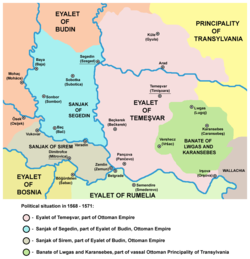Top Qs
Timeline
Chat
Perspective
Banate of Lugos and Karánsebes
From Wikipedia, the free encyclopedia
Remove ads
Banate of Lugos and Karánsebes (Hungarian: Karánsebesi-Lugosi bánság, Romanian: Banatul de Lugoj-Caransebeș, Serbian: Лугошка и карансебешка бановина, romanized: Lugoška i karansebeška banovina) was an administrative and territorial entity (banate) of the Eastern Hungarian Kingdom and the Principality of Transylvania. It existed from the first half of the 1536, up to the 1658. The banate was organized as a militarized border area, created in order to defend the region from the advancing Ottoman Empire. Centered in cities of Lugoj and Caransebeș, it was encompassing the south-eastern part of the modern region of Banat, inhabited in those times by Hungarians, Romanians and Serbs.[1][2][3][4][5]
Remove ads
History
The Banate of Lugos and Karánsebes was formed gradually between 1526 and 1536, after the battle of Mohács, when the Banate of Severin was divided. Its eastern side, from Orsova (present-day Orșova), came under the jurisdiction of the Wallachian ruler. In the western part, this new political and military border entity was formed.
In 1658, the new Prince of Transylvania, Ákos Barcsay, ceded the region to the Ottoman Empire.
Remove ads
Cities
The Banate of Lugoj and Caransebeș included the following cities:
Bans of Lugoj and Caransebeș
- Michael de Somlya (1536)
- Péter Petrovics (1544–1549)
- John Glessan (1552)
- Gregory Bethlen of Iktár (1563)
- Gabriel Bethlen of Iktár (1564)
- Stephen Trompa (1575–1577)
- Gregory Palotić (fl. 1594)
- Paul Keresztesy (1605–1606) and (1610–1613)
- Ákos Barcsay (1644-1658)
See also
References
Sources
External links
Wikiwand - on
Seamless Wikipedia browsing. On steroids.
Remove ads

